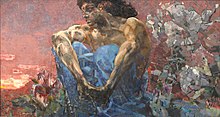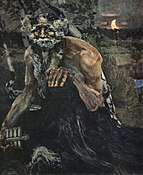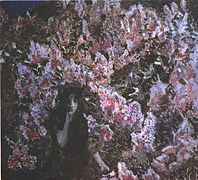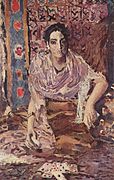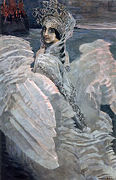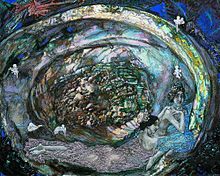Mikhail Alexandrovich Wrubel
Mikhail Vrubel ( Russian Михаил Александрович Врубель ., Scientific transliteration Mikhail Aleksandrovich Vrubel ' . English transcription: Mikhail Aleksandrovich Vrubel ; born March 5 . Jul / 17th March 1856 greg. In Omsk , † April 1 jul. / 14th April 1910 greg. In Saint Petersburg ) was a Russian painter , sculptor , ceramist and set designer of Symbolism and Art Nouveau .
Life
He studied first at St. Petersburg University and then from 1880 to 1884 at the St. Petersburg Academy of Art . From 1884 to 1889 he lived in Kiev , where he made several sketches for the frescoes in the Vladimir Cathedral on behalf of the local clergy and participated as a painter in the completion and restoration of the frescoes in the Kyrill Church there. In 1889 he moved to Moscow , where he became a member of the circle of artists around the Russian patron Mamontow and also worked in the Abramzewo artists' colony .
Wrubel's style is characterized by the dramatic intensity of color and "crystalline" clarity. His works were characterized by subjective-mystical ideas and allegories . In particular, his illustrations for Mikhail Lermontov's poem “ The Demon ” were deeply pessimistic and tense and dramatic, which established his fame as one of the leading representatives of symbolism. The motifs for his works arose from traditional Russian fairy tales and heroic epics ( Bylinen ) as well as from Western classical literature. In his work he strived for a great monumentality and strong psychological effect on the viewer. Until his death, Wrubel remained a point of reference for many students and imitators. Wrubel also worked for the theater and, in addition to Lermontov's poems, illustrated Leo Tolstoy's novel Anna Karenina .
A great niece of Wrubels was the human rights activist Tatiana Sergejewna Chodorowitsch .
Works (selection)
Exhibition (selection)
- 2017: Works by Wrubel, including the fireplace cladding depicting the Russian folk epic Mikula and Volga. Moscow splendor of the Tsarist era - ceramic treasures from the Kolomenskoje Museum , Hetjens Museum , Düsseldorf
- 1997: Michail Wrubel - The Russian Symbolist, Kunsthalle Düsseldorf and Haus der Kunst , Munich
literature
- Bol'saja sovetskaja enziklopedia (The Great Soviet Encyclopedia), Vol. 9. Moscow, 1951.
Web links
- Literature by and about Michail Alexandrowitsch Wrubel in the catalog of the German National Library
- Michail Alexandrowitsch Wrubel in Google Arts & Culture
- Information about the artist and his works (Russian)
- Personalities of Russian History Mikhail Vrubel by Olga Korschilowa , on radio (sputniknews.com): Voice from Russia, December 1, 2012
Single receipts
- ^ Ceramics by a symbolist, in Rheinische Post, from January 31, 2017
- ↑ Haus der Kunst, exhibition May 8th - July 20th 1997: Michail Wrubel - The Russian Symbolist
| personal data | |
|---|---|
| SURNAME | Wrubel, Mikhail Alexandrovich |
| ALTERNATIVE NAMES | Врубель, Михаил Александрович (Russian) |
| BRIEF DESCRIPTION | Russian painter of symbolism |
| DATE OF BIRTH | March 17, 1856 |
| PLACE OF BIRTH | Omsk |
| DATE OF DEATH | April 14, 1910 |
| Place of death | St. Petersburg |


